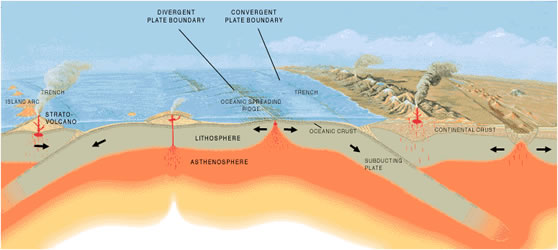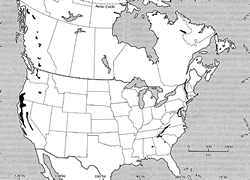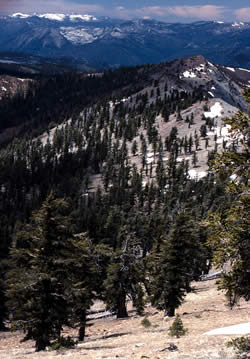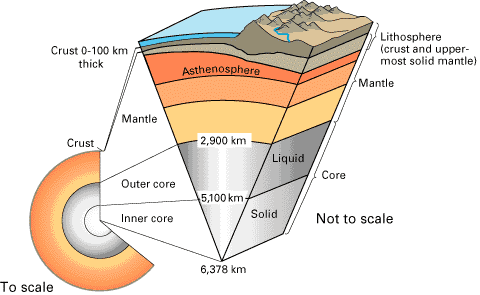USDA Forest Service Celebrating Wildflowers
|
|
|
GeologyWhere the Earth's Crust Collides, Serpentine is BornUnique serpentine communities owe their origin to geologic processes that began 440 million years ago deep within the middle of the earth.
Serpentine rock, so called because the pattern of the rock surface resembles a serpent’s skin, is actually a rock type originally formed from ultramafic rock. Ultramafic rock, rich in iron and magnesium, forms within the earth’s mantle and finds its way to the surface along oceanic ridges where new ocean crust is formed. Underlying this new crust is partially melted ultramafic rock which essentially forms the basement of the ocean crust. Ultramafic rock migrates across the ocean floor along with the crust. A process called plate tectonics drives crustal movement. As sea floor spreads from the oceanic ridge, it eventually collides against the continental crust or plate. In a process called subduction, most of the rigid ocean crust, dragging along ultramafic rock, is thrust beneath the continental crust and recycled back into the earth’s mantle. Not all crust material ends up back in the mantle. Slabs of ultramafic-bearing crust called ophiolites are left behind and embedded in a matrix of sediment along a subduction trench. Ophiolites can be subsequently lifted in the course of subduction while others are added or accreted on to continental crust by faulting or folding along the continental margin. Ultramafic rocks are also incorporated onto the continent in association with volcanic activity related to subduction along the continent’s edge. Such is origin of ultramafic rock in the Sierra Nevada Mountains. As dismembered slabs and sections of ocean crust, ultramafic areas are geographically distributed as linear or irregular patches, existing as geologic islands.
The largest ultramafic area in North America is associated with the tectonically active Klamath-Siskiyou Mountains. The genesis of this area in northwest California and southwest Oregon is directly linked to ancient accretion events marking the collision of oceanic crust against continental crust. Some of the oldest accretion events in these mountains date back to the Paleozoic era, about 440 million year ago, when seas covered most of the land mass. Visit The Josephine Ophiolite website that explains ophiolites in general and the Josephine Ophiolite in particular, including a self-guided tour. In addition, visit the Naturally Occurring Asbestos website for more information about the natural geologic occurrence of various types of asbestos that is commonly found in ultramafic rock formations, including serpentine in California. This website includes maps of serpentine distribution in California and its national forests. Now that we have provided the origins of serpentine rock from inside the earth, under the water, and under the ground, let's come to the surface in a description of Serpentine Soils and Plant Adaptations. Bookmarksmantle - The mantle is one of the layers of the earth nested between the core and the crust. The mantle itself exists as layers, the outer and the inner. The layers vary by chemistry and consistency with the inner mantle being composed of partially melted material and the uppermost layer, closest to the crust; being rigid. The uppermost mantle is composed of periodotite rock and other olivine rich rock types. Jointly, the upper mantle and crust are called the lithosphere.
Graphic by U.S. Geological Service. plate tectonics - Plate tectonics is the theory that the shell of earth is made of rigid plates, oceanic and continental, that move relative to one another. These plates move atop the semi-melted portion of the earth’s mantle called the athenosphere. The area where the ocean plate collides with the continental plate is called a convergent boundary. At this boundary, the oceanic plate slides underneath the continental plate in a process called subduction. Subduction leads to mountain building events including volcanoes and earthquakes. ophiolite - Ophiolite is a composite of the ocean crust consisting of marine sediments, volcanics and ultramafic rock. In mountain building areas, where ocean crust collides with continental crust, slabs of this composite are accreted to the continent. The ultramafic-bearing composite is termed an ophiolite. Resources and References
|
|
| NOTE: PDF format links require the Adobe Acrobat Reader to view. | |
| top | Disclaimers | FOIA | Privacy Policy | Quality of Information | Photo Credits & Use |
Location: http://www.fs.fed.us/wildflowers/communities/serpentines/geology.shtml
Last modified: Thursday, 12-Feb-2009 17:10:24 EST



